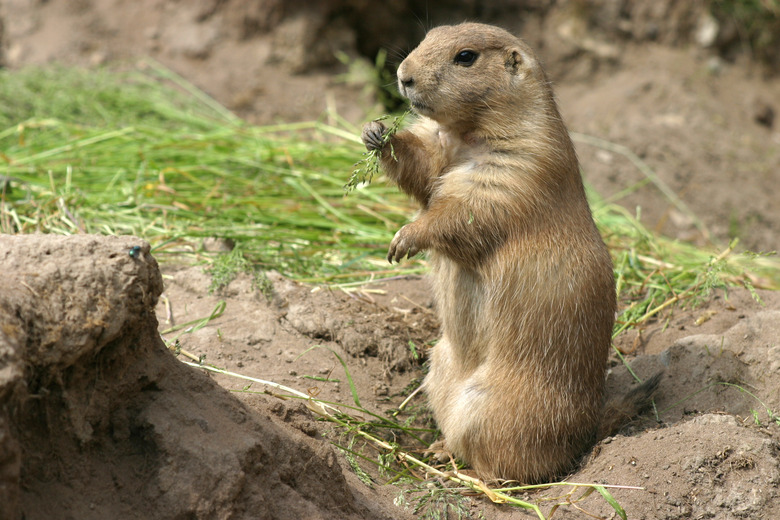How To Get Rid Of Prairie Dogs
They have a close family life, take care of the kids, mow the grass and they're cute. They're prairie dogs, and despite these traits, they're often not appreciated. In some areas, they're perceived as competing with livestock for grazing, or their colonies take up valuable real estate. Since they harbor fleas that can spread plague, they're not welcome neighbors. Once present over the entire Great Plains, during the 1900s more than 98 percent of prairie dogs were eradicated, and they now occupy about 5 percent of their historic range. (see Reference 2)
Physical Measures
If prairie dog towns are plowed up or disked over, that can reduce the population. Level off the ground with a tractor blade the year after plowing to slow burrow rebuilding. Don't plant anything for two years, and then plant tall grasses. Use this method in areas where soil erosion isn't likely to occur. (see Reference 3) Sometimes prescribed burning of grassland will renew growth to the point where tall grasses regenerate and the area becomes unsuitable for prairie dogs. (see Reference 3)
Toxicant Use
Zinc phosphide poison bait is available for prairie dog control, but only to certified pesticide applicators. It acts by combining with stomach acids to produce the toxin hydrogen phosphide, and if a prebait is used before poison bait application, it can kill 67 to 97 percent of the population. (see Reference 1) It's usually applied in late summer or fall when natural forage is less abundant. It shouldn't be used more than once a year. Although prairie dogs usually die within their burrows, two or three days after poison bait application remove and bury any aboveground dead animals. (see Reference 3) If you live in Utah, be aware that the Utah prairie dog is a threatened species regulated by federal recovery plans. (see Reference 6)
Fumigation Application
Two kinds of fumigants are used for prairie dog control. Aluminum phosphide tablets, which release hydrogen phosphide, are only available to certified pesticide applicators. Gas cartridges are available for private use. After insertion into a burrow and ignited, the cartridges release carbon monoxide. Fumigants aren't selective and kill anything within the burrow. Most states require a survey for the protected black-footed ferret, a prairie dog predator, before fumigant use. Other animals at risk during fumigation include burrowing owls, badgers, and tiger salamanders. (see Reference 1) Fumigants need moist soil to be most effective, and provide 85 to 95 percent control if used correctly. (see Reference 3)
Tall Grass Advantages
Prairie dogs prefer to live in areas with short vegetation such as short-grass prairie or overgrazed land. They keep the plants around their towns eaten down for better predator visibility. They can't establish in areas with medium- or tall-sized grasses unless livestock have eaten it down. To make conditions less favorable for prairie dogs, reduce the number of livestock per acre and give overgrazed lands a resting period. Prairie dogs relocate if the tall grass regrows. (see Reference 3)
Other Methods
A number of other prairie dog control methods either aren't cost effective or don't reliably reduce populations. Shooting animals with .22 rifles does reduce populations as much as 65 percent in a given year, but is time-consuming and usually not cost-effective. (see References 4 and 2) Devices that inject propane and oxygen to blow up the underground burrows were approved for use in Colorado in 2006. (see Reference 7 and Reference 2, page 131) One inventor redesigned a street sweeper to vacuum prairie dogs out of their burrows. (see Reference 3, Other Methods) Trapping may be effective in 1- to 5-acre colonies over time. (see Reference 3, Trapping)
References
- Conservation of the Black-Tailed Prairie Dog; John Hoogland
- National Geographic: Prairie Dog Cynomys Ludovicianus
- New Mexico State University Cooperative Extension Service: Prairie Dog Control in New Mexico
- The Denver Post: Explosives a Go For Prairie Dogs
